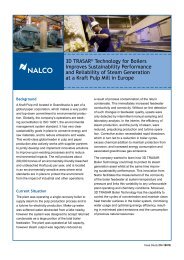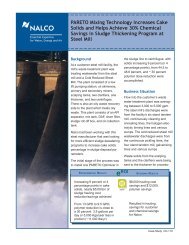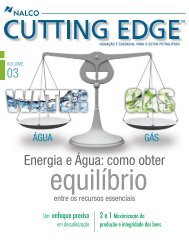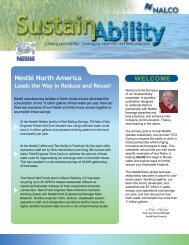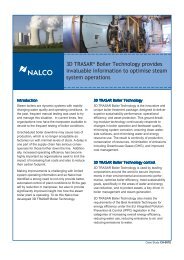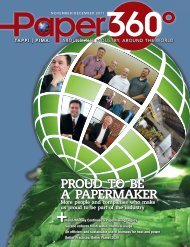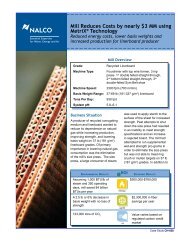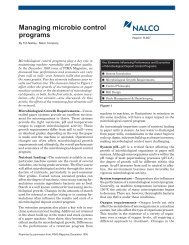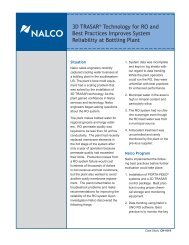New 3D TRASAR® Membrane Technology increases plant ... - Nalco
New 3D TRASAR® Membrane Technology increases plant ... - Nalco
New 3D TRASAR® Membrane Technology increases plant ... - Nalco
Create successful ePaper yourself
Turn your PDF publications into a flip-book with our unique Google optimized e-Paper software.
Introduction<br />
FASCA, a company based in southern Europe, is<br />
focused on delivering integrated water management<br />
solutions. The company operates several Reverse<br />
Osmosis (RO) <strong>plant</strong>s in the region that are used to<br />
produce and distribute potable water. <strong>Nalco</strong> technology<br />
has been used to successfully treat these RO<br />
<strong>plant</strong>s since their start-up some years ago, and some<br />
of the RO trains currently use <strong>Nalco</strong> RO TRASAR<br />
technology for process monitoring and control.<br />
This first-generation TRASAR ® technology has been<br />
shown to be extremely reliable and is valued by the<br />
customer because the monitoring and control offered<br />
helps to consistently maintain <strong>plant</strong> performance<br />
and reduce operational costs. From the moment<br />
<strong>New</strong> <strong>3D</strong> TRASAR ® <strong>Membrane</strong> <strong>Technology</strong><br />
<strong>increases</strong> <strong>plant</strong> efficiency and reduces<br />
operational risks in potable water<br />
production<br />
EnviRonmEntal REsults e ROI<br />
Reduction in fresh water demand of over<br />
41000 m3 (6.25%) per year through improved<br />
water use efficiency<br />
Additional reduction in water use eliminated<br />
annual wastewater volume of over 41000 m3 (>25%)<br />
Reduction in energy demand for production<br />
equivalent to 9.31% per year based upon<br />
kWh/m 3<br />
Overall annualised 15.5% reduction in<br />
treatment programme consumables<br />
All data verified by the customer<br />
Economic REsults<br />
Conservation of precious groundwater acquifer<br />
water resources in a water-stressed area<br />
Annualised savings in disposal costs of €3580<br />
Annualised savings in energy costs of €2670<br />
Annualised savings of over €2500<br />
Overall annualised reduction in the Total<br />
Cost of Operation of €8750<br />
they were commissioned, the RO TRASAR units<br />
demonstrated their value by detecting dosing pump<br />
failures and highlighting any incorrect dosage levels,<br />
allowing rapid correction and subsequent optimisation<br />
of treatment application, system protection and<br />
efficiency. The technology helped the customer avoid<br />
severe scaling problems and the unplanned cleaning<br />
or membrane replacement costs that would inevitably<br />
result. As a result of this long-term track record of<br />
success and experience with the TRASAR technology<br />
programme, the customer was very eager to receive<br />
the next-generation technology as it became available.<br />
<strong>Nalco</strong> subsequently launched this technology<br />
advance under the name of <strong>3D</strong> TRASAR <strong>Membrane</strong><br />
<strong>Technology</strong>, and this customer was one of the first<br />
recipients of the new programme.<br />
Case Study CH-1158E
Background<br />
The customer selected one of its potable water<br />
production <strong>plant</strong>s to receive the new technology.<br />
The <strong>plant</strong> selected is made up of a Reverse<br />
Osmosis <strong>plant</strong> with two trains, each producing<br />
125 m 3 /h of permeate. The feed water is well water,<br />
which has very stable water quality and temperature.<br />
As a result of the excellent feed water quality and<br />
the protection provided by the original <strong>Nalco</strong> RO<br />
TRASAR technology, including advanced antiscalant<br />
chemistries, it has never been necessary to clean<br />
the membranes in the system.<br />
Each RO train includes:<br />
• 1 media filter<br />
• 1 cartridge filter<br />
• 1 high pressure pump<br />
• RO system, 2 stages (14:7) with six membranes<br />
of various types per vessel<br />
• <strong>Nalco</strong> PermaTreat ® technology is applied to<br />
each train<br />
Due to the pattern of water demand, only one train<br />
runs at a time, running for eighteen hours per day.<br />
The trains are rotated every week.<br />
Implementation<br />
The installation of <strong>3D</strong> TRASAR <strong>Membrane</strong> <strong>Technology</strong><br />
at the site included the full suite of monitoring and<br />
control capabilities. Initially, control of the existing<br />
antiscalant programme was maintained using the<br />
existing RO TRASAR system. The new <strong>3D</strong> TRASAR<br />
system was run in parallel but not yet with control<br />
Figure 1 – Schematic showing the layout of data-gathering points used to control the<br />
antiscalant programme<br />
2<br />
of the antiscalant. This allowed values from both<br />
the RO TRASAR and <strong>3D</strong> TRASAR systems to be<br />
compared and accuracy and reliability to be demonstrated.<br />
To define the operating limits of a cooling<br />
water system when using a new programme strategy,<br />
<strong>Nalco</strong> typically uses <strong>3D</strong> TRASAR Optimiser<br />
technology, a sophisticated process optimisation tool<br />
which identifies the advanced comprehensive treatment<br />
management programme necessary to protect<br />
a system from scale, corrosion, and microbiological<br />
fouling. As a result of this analysis, a new treatment<br />
regime was proposed, using the <strong>3D</strong> TRASAR<br />
system. This moved away from the traditional<br />
programme, to one based upon automated real-time<br />
control of system parameters, and containing advanced<br />
chemistry to deliver comprehensive control<br />
of both corrosion and scale, and a unique polymer<br />
to deliver advanced corrosion protection. The use of<br />
the polymer also ensured good dispersancy and protection<br />
of all types of metallurgy that were present in<br />
the system.<br />
The samples and signals from sensors needed for<br />
monitoring, control and normalisation calculations<br />
for the <strong>3D</strong> TRASAR system are shown in Figure 1.<br />
• Fluorometers A, B and C measure the<br />
fluorescence values of the untreated feedwater<br />
(background), treated feedwater and concentrate.<br />
• C1 feed conductivity and temperature values are<br />
obtained from <strong>3D</strong> TRASAR probes. C2 permeate<br />
conductivity is taken from an existing customer<br />
sensor.
• P1, P2, P4 pressure values are taken from existing<br />
customer sensors. There is no sensor for P5<br />
permeate pressure, needed for normalisation, but<br />
this is a constant value (0.3 bar).<br />
• F1 permeate flow and F2 concentrate flows are<br />
taken from existing customer sensors.<br />
The following additional signals are also received by<br />
the customer’s control unit:<br />
• Pressure values (pre- and post-sand filters)<br />
• Pressure value (post-cartridge filters)<br />
• pH and ORP from fluorometer B<br />
• Concentrate conductivity from fluorometer C<br />
In order to send all of these data to the <strong>3D</strong> TRASAR<br />
unit, a splitter box was prepared to split the signals<br />
from the Programmable Logic Controller (PLC)<br />
(as shown in Figure 2).<br />
Figure 2 – Splitter box used to manage<br />
signals between the RO trains and the<br />
<strong>3D</strong> TRASAR unit.<br />
The <strong>3D</strong> TRASAR unit was connected to the<br />
internet via a <strong>Nalco</strong> Global Gateway (NGG) to<br />
record and analyse data, and to run the <strong>Nalco</strong><br />
‘UNO’ normalisation tool.<br />
Description<br />
<strong>3D</strong> TRASAR <strong>Technology</strong><br />
<strong>3D</strong> TRASAR <strong>Technology</strong> management programmes<br />
are used in many different types of water preparation<br />
and management system to deliver on-demand<br />
control and optimisation of water chemistry, continuously<br />
protecting the systems from scale formation<br />
and fouling, ensuring optimised operational efficiency<br />
and continuity of production.<br />
• Protection of systems avoids premature and<br />
costly replacement of non-renewable materials<br />
• Scale and fouling control maximises operational<br />
efficiency and reduces costs<br />
3<br />
• Better water resource management minimises<br />
the demand for costly renewable resources, and<br />
safeguards public water supplies<br />
<strong>3D</strong> TRASAR <strong>Technology</strong> is used by thousands of<br />
corporations around the world to:<br />
• Secure improvements in their environmental and<br />
economic performance<br />
• Optimise system efficiency<br />
• Help them to meet their sustainability goals,<br />
specifically in the areas of water and energy use<br />
reduction<br />
<strong>3D</strong> TRASAR technology control systems take<br />
account of the inherent variability in system water<br />
conditions, maintaining protection from scale and<br />
fouling by predicting problems and intervening<br />
before they occur. The programme controls system<br />
chemistry, dosing on-demand and minimising the<br />
amount of materials added to the system, thereby<br />
reducing costs without prejudicing system integrity.<br />
<strong>3D</strong> TRASAR <strong>Membrane</strong> <strong>Technology</strong><br />
This technology is the new generation of the <strong>Nalco</strong><br />
RO TRASAR platform for the performance management<br />
of membrane systems. <strong>3D</strong> TRASAR <strong>Membrane</strong><br />
technology allows monitoring and control<br />
of antiscalant programmes and monitoring of key<br />
parameters for the membrane system: flows, pressures,<br />
feed water temperature and conductivities.<br />
This information is collected by the <strong>3D</strong> TRASAR<br />
Control unit from <strong>plant</strong> sensors and sent to the<br />
centralised <strong>Nalco</strong> <strong>3D</strong> TRASAR website via<br />
<strong>Nalco</strong> Global Gateway (NGG) to be normalised<br />
and trended. Customers are able to access this<br />
information on their own specific web page. Furthermore,<br />
the <strong>Nalco</strong> 360 Service team checks this data<br />
on a regular basis and makes recommendations<br />
about the continuous optimisation and improvement<br />
of <strong>plant</strong> operations.<br />
The <strong>3D</strong> TRASAR unit collects data from membrane<br />
systems through:<br />
• TRASAR chemistry, ORP, pH and conductivity<br />
sensors on the unit<br />
• Signals from the existing sensors through PLCs<br />
or signal splitters<br />
• Signals from new sensors that are added if<br />
needed
The basic hardware package includes everything<br />
necessary to monitor and control the antiscalant<br />
programme in a multi-train system: 3 fluorometers<br />
to measure the background fluorescence and the<br />
antiscalant in the feed and the concentrate; pH; ORP<br />
and conductivity probes and a platform for analogue<br />
inputs from <strong>plant</strong> sensors. A typical configuration is<br />
shown in Figure 3.<br />
Figure 3 – <strong>3D</strong> TRASAR <strong>Membrane</strong> <strong>Technology</strong>: typical<br />
control unit configuration<br />
The system can be customised for each system or<br />
customer need, and hardware can include more fluorometers<br />
(6), ORP and pH probes, PID (4), analogue<br />
inputs (20) and connectivity to a PLC.<br />
Results<br />
At this customer site, the <strong>3D</strong> TRASAR unit ran in<br />
monitoring mode only for the first few weeks.<br />
During this period, the baseline operational status<br />
was determined by recording the normal system<br />
dynamics, and the data were checked for any<br />
upsets. The main initial advantage of using the new<br />
technology became quickly apparent through the<br />
availability of a much wider array of information on<br />
system performance than previously available.<br />
The <strong>3D</strong> TRASAR data showed that the Reverse<br />
Osmosis system was operating with a very high<br />
degree of stability, with no fouling or other operational<br />
issues affecting <strong>plant</strong> performance. Data for<br />
normalised differential pressure across the system<br />
for the first 7 weeks of the monitoring period are<br />
shown in Figure 4 below.<br />
Figure 4 – Graph showing Differential Pressure (DP) across two stages of the RO system.<br />
4<br />
The differential pressure was found to be higher<br />
across the first stage due to previous fouling by iron<br />
oxide particles from a previous episode of corrosion<br />
of a high pressure pump. The second stage membranes<br />
had a higher surface area and were almost<br />
new giving a resultant lower differential pressure.
Figure 5 shows data for the normalised permeate<br />
flow during the initial monitoring period. The<br />
<strong>3D</strong> TRASAR unit and the NGG demonstrated their<br />
ability to receive, send and analyse all of the data<br />
necessary to provide reports publishing normalised<br />
data.<br />
Normalised data report<br />
Key performance parameters are influenced by<br />
water temperature, pressure and feed water Total<br />
Dissolved Solids (TDS). Normalisation is the way<br />
to compensate for the effect of these variables and<br />
standardise data, allowing comparisons and to see<br />
trends of the actual performance of the RO system.<br />
The capability of the <strong>3D</strong> TRASAR unit to generate<br />
normalised data reports means the customer has<br />
easy access to actual <strong>plant</strong> performance. Currently,<br />
normalised data reports have to be prepared manually.<br />
The <strong>Nalco</strong> system continuously and automatically<br />
provides critical information about <strong>plant</strong><br />
performance, saving time and resources that can<br />
now be used elsewhere.<br />
An additional advantage of the <strong>3D</strong> TRASAR <strong>Membrane</strong><br />
technology includes the ability to check <strong>plant</strong><br />
recovery rates using readings from the values of<br />
TRASAR chemistry detected in both the feed and<br />
concentrate. Figure 6 shows a comparison between<br />
the percentage <strong>plant</strong> recovery determined by using<br />
the <strong>3D</strong> TRASAR <strong>Membrane</strong> technology, and also<br />
by flow.<br />
The peaks shown on the graph are due to shutdown<br />
and start-up periods. In this case the graph plots<br />
from both sources of data are largely superimposed,<br />
indicating that the <strong>3D</strong> TRASAR <strong>Membrane</strong> technology<br />
provides an important double-check on the<br />
traditional flow measurement. In other <strong>plant</strong>s, flow<br />
meters may not be as reliable, and therefore the<br />
<strong>Nalco</strong> programme offers the only way of accurately<br />
identifying the correct recovery.<br />
Once the baseline of <strong>plant</strong> performance had been<br />
determined by running the <strong>3D</strong> TRASAR system in<br />
monitoring mode for approximately seven weeks, the<br />
control of the antiscalant programme was switched<br />
over from the original RO TRASAR system to the<br />
new <strong>3D</strong> TRASAR system. The antiscalant dosage<br />
set-point remained the same as before, at 3 ppm,<br />
with a low failsafe limit of 2 ppm. The system was<br />
then allowed to run in control mode for one month.<br />
During the period of control mode operation, the<br />
accuracy of the dosage of antiscalant was increased<br />
as a result of the ability of the <strong>3D</strong> TRASAR system<br />
to monitor background fluorescence in real-time.<br />
This allowed dosages to be calculated relative to<br />
the background, thus eliminating unnecessary extra<br />
antiscalant addition. Under the original RO TRASAR<br />
control regime, the customer had had to increase<br />
the set-point to 3.2 ppm in order to maintain the<br />
required 3 ppm dosage due to the constant input of<br />
background fluorescence during configuration. The<br />
advantage of having an online background fluores-<br />
Figure 5 – Normalised Permeate flow data for the first five weeks of initial monitoring on the RO system.<br />
5
Figure 6 – Comparison of recovery rates as determined by <strong>3D</strong> TRASAR technology detection, and by flow<br />
measurement.<br />
cence reading was that this background fluorescence<br />
value was measured and compensated for,<br />
continuously providing a more accurate dosage<br />
(as shown in Figure 7 below).<br />
As soon as the <strong>3D</strong> TRASAR unit was confirmed as<br />
running well in control mode, it was decided to use<br />
the monitoring and normalisation capabilities of the<br />
unit to increase the percentage <strong>plant</strong> recovery to<br />
check for potential operational cost savings. It was<br />
agreed with the customer that the <strong>plant</strong> recovery<br />
Figure 7 – Reduction in antiscalant dosing through compensation for background fluorescence by the <strong>3D</strong> TRASAR<br />
<strong>Membrane</strong> <strong>Technology</strong> (new unit).<br />
6
would be increased from the original 75% to run at<br />
77% recovery for five days and, if successful, to run<br />
for an additional five days at 80% recovery. During<br />
both periods data were to be normalised to control<br />
<strong>plant</strong> performance and detect any issues at early<br />
stage.<br />
The <strong>plant</strong> was set to run at higher recovery rates, but<br />
would still continue to produce the same permeate<br />
flow. The main potential savings would be delivered<br />
by lowering both the cost of the concentrate flow<br />
discharge, and the energy costs due to lower energy<br />
costs (kWh/m 3 ). Overall, the expected potential cost<br />
savings included:<br />
• Feed water flow reduction (conservation of the<br />
groundwater aquifer water resources in a waterstressed<br />
area).<br />
• Feed water pumping costs and energy<br />
• Overall programme operational costs (even maintaining<br />
the same dosage the feed water treatment<br />
cost would be 6% lower at 80% recovery).<br />
Figures 8 & 9 demonstrate the normalised permeate<br />
flow data for the periods of <strong>plant</strong> operation at 77%<br />
and 80% recovery respectively.<br />
One of the customer’s key concerns was to control<br />
the nitrate level in the permeate water. However,<br />
even during the two higher recovery periods, there<br />
was only a 9 µS/cm increase in permeate conductivity.<br />
The nitrate concentration remained within the<br />
required limits and an even a better salt passage<br />
was confirmed (see Figure 10).<br />
Figure 8 – Normalised Permeate flow data at 77% recovery for the first four days when using <strong>3D</strong> TRASAR<br />
control<br />
Figure 9 – Normalised Permeate flow data at 80% recovery for the first four days when using <strong>3D</strong> TRASAR<br />
control<br />
7
After 5 days working at the highest recovery, Train<br />
1 was shut down and production rotated to Train 2.<br />
After the successful evaluation of the <strong>plant</strong> at higher<br />
recovery rates, the <strong>plant</strong> was reset to its baseline<br />
75% recovery to ensure that optimised normal<br />
operation could be restored.<br />
Summary<br />
The implementation of innovative and progressively<br />
enhanced TRASAR technology at this customer<br />
<strong>plant</strong> has continuously demonstrated the capability<br />
to deliver specific benefits. These have historically<br />
included:<br />
• Consistent operation of the Reverse Osmosis<br />
<strong>plant</strong>, avoiding problems from scaling and the related<br />
costs of membrane cleaning or replacement.<br />
• Progressive reduction in the treatment programme<br />
component delivering reductions in cost, lowering<br />
the number of deliveries, and reducing the associated<br />
impacts of transportation upon fuel use,<br />
emissions, and the local community.<br />
The following additional benefits have now been<br />
demonstrated after the implementation of the new<br />
<strong>3D</strong> TRASAR <strong>Membrane</strong> technology:<br />
• Enhanced dosage control<br />
• Increased dosage accuracy<br />
• Online data collection and analysis<br />
Figure 10 – Percentage salt passage at 75% and 80% recovery<br />
• Customer access to reports publishing normalised<br />
data<br />
• Reduced environmental impact due to lower feed<br />
water needs and lower concentrate rejection<br />
• No impact on the final water quality<br />
Reduction in the overall Total Cost of Operation by<br />
€8750 per year has been delivered, and has been<br />
verified by the customer, including:<br />
• Reduction in feedwater demand by 41667 m3 /year<br />
(6.25%)<br />
• Reduction in water rejection and disposal of<br />
41667 m3 /year (>25%),saving €3580 per year<br />
• Reduction in energy demand by 9.31% per year<br />
based on kWh/m3 , saving €2670 per year<br />
• Reduction in treatment programme consumables<br />
of 15.5% due to lower requirements at 80%<br />
recovery (lower feed water to treat), saving up to<br />
€2500 per year<br />
Conclusion<br />
Results obtained with the new <strong>3D</strong> TRASAR <strong>Membrane</strong><br />
technology were again able to demonstrate<br />
that this is an even more powerful diagnostic,<br />
monitoring and control programme, representing a<br />
significant advance over earlier technology. It can<br />
be used to achieve measurable economic savings,<br />
improve performance, control, and give peace of<br />
mind to the operators of Reverse Osmosis systems.<br />
<strong>Nalco</strong> reports Environmental Return on Investment (eROI) values to customers to account for contributions in delivering both<br />
environmental performance and financial payback.<br />
NALCO COMPANY Locations<br />
North America: Headquarters – 1601 West Diehl Road • Naperville, Illinois 60563 • USA<br />
Energy Services Division – 7705 Highway 90-A • Sugar Land, Texas 77487 • USA<br />
Europe: A-One Business Center • Z.A. La Pièce 1 • Route de l’Etraz • 1180-Rolle • Switzerland<br />
Asia Pacific: 2 International Business Park • #02-20 The Strategy Tower 2 • Singapore 609930<br />
Latin America: Av. das Nações Unidas 17.891 • 6° Andar 04795-100 • São Paulo • SP • Brazil<br />
www.nalco.com<br />
<strong>3D</strong> TRASAR, <strong>Nalco</strong> 360, eROI, NALCO and the logos are Trademarks of <strong>Nalco</strong> Company<br />
PermaTreat is a trademark of <strong>Nalco</strong> Limited<br />
©2011 <strong>Nalco</strong> Company All Rights Reserved 7-11




